In a previous article, we delved into the historical significance of One Observatory Circle, shedding light on its dual role as both the Naval Observatory and the official residence of the Vice President. However, an intriguing fact often overlooked is that the U.S. Naval Observatory, housed within these esteemed grounds, boasts the possession of the world’s most precise and accurate timekeeping device. This remarkable achievement exemplifies the Observatory’s unwavering commitment to the pursuit of precision, making it not only a center of historical importance but also a cornerstone of cutting-edge scientific research in the field of timekeeping and astronomy.
At the twelve o’clock position of One Observatory Circle – seems fitting.

The U.S. Naval Observatory (USNO) is charged with the responsibility for precise time determination and management of time dissemination. Modern electronic systems, such as electronic navigation or communications systems, depend increasingly on precise time and time interval (PTTI). Examples would be the now decommissioned ground-based LORAN-C navigation system and the satellite-based Global Positioning System (GPS). These systems are based on the travel time of the electromagnetic signals: an accuracy of 10 nanoseconds (10 billionths of a second) corresponds to a position accuracy of 10 feet. In fast communications, time synchronization is equally important. All of these official systems are referenced to the USNO Master Clock.
The Master Clock timescale of the Observatory is based on an ensemble of cesium-beam frequency standards, hydrogen masers, and rubidium fountains. Frequency data from this ensemble are used to steer the frequency of a single maser, forming our designated Master Clock (MC), until its time equals the average of the ensemble, thereby providing the physical realization of this “paper timescale.”
Specifically, the frequency of a device called an Auxiliary Output Generator is periodically adjusted so as to keep the time of this maser synchronized as closely as possible with that of the computed mean timescale USNO timescale UTC(USNO), which in turn adjusted to be close to the predicted UTC. The unsteered internal reference timescale is designated as A.1, while the reference of the actual Master Clock is called UTC(USNO).
UTC(USNO) is usually kept within 10 nanoseconds of UTC. An estimate of the slowly changing difference UTC – UTC(USNO) is computed daily.These clocks are distributed in environmentally controlled clock vaults in several buildings to ensure their stability. By automatic inter-comparison of all clocks every 100 seconds, the USNO time scale can be computed which is not only reliable but also extremely stable. Its rate does not change by more than about 100 picoseconds (0.000 000 000 1 seconds) per day from day to day.
On the basis of this computed time a clock reference system can be steered to produce clock signals which serve as the USNO Master Clock. The clock reference system is driven by a hydrogen maser atomic clock. Hydrogen masers are extremely stable clocks over short time periods (less than one week). They provide the stability, reliability and accessibility needed to maintain the accuracy of the Master Clock system.
United States Naval Observatory. “The USNO Master Clock.” Chief of Naval Operations N2N6, Precise Time Department, Date Accessed: [Insert Date], URL: https://www.cnmoc.usff.navy.mil/Our-Commands/United-States-Naval-Observatory/Precise-Time-Department/The-USNO-Master-Clock/The-USNO-Master-Clock/.

